Milch Kine Meaning in the Bible: Sacred Cows
In biblical contexts, ‘milch kine‘ refers to cows actively producing milk, underscoring their essential role in the agrarian and economic fabric of ancient societies. These animals were symbols of sustenance, prosperity, and divine favor, often appearing in scriptural narratives to illustrate themes of provision and fertility.
For instance, their mention in 1 Samuel 6, during the return of the Ark of the Covenant, signifies divine intervention and care. Over time, translations evolved, but the symbolic richness remained intact, reflecting continuity in agricultural and spiritual life.
To grasp the full cultural and theological implications, further exploration is warranted.

Milch Kine Meaning in the Bible: Symbolism of Cows and Divine Guidance
| Aspect | Details |
|---|---|
| Definition | Milch kine refers to milk-producing cows |
| Biblical Reference | Found in 1 Samuel 6:7–12 during the return of the Ark of the Covenant |
| Context | Two milch kine carried the Ark without being led, showing divine intervention |
| Symbolism | Represents obedience, submission to God’s will, and miraculous guidance |
| Spiritual Lesson | Emphasizes trusting in God’s direction even when it defies natural instinct |
Definition of Milch Kine
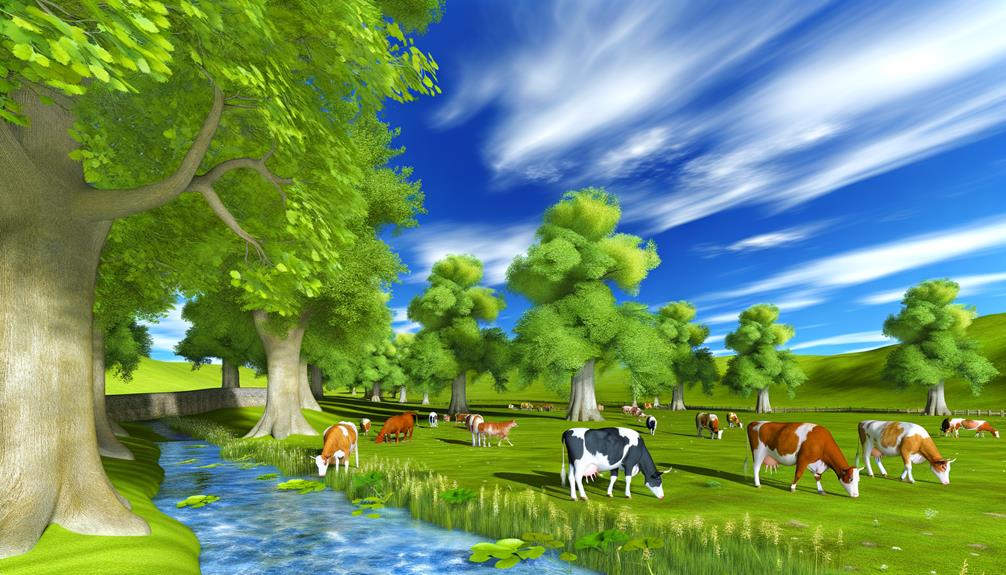
The term ‘milch kine‘ in the Bible refers to cows that are currently producing milk, often highlighting their role in agricultural and economic contexts within biblical narratives.
This designation underscores the importance of these animals in ancient agrarian societies, where milk production was a critical resource for daily sustenance and trade.
The biblical usage of ‘milch kine’ not only describes their physiological state but also implies their value within the community. Such references illustrate the integral part these animals played in the broader socio-economic fabric, providing insight into the pastoral practices of the time. Moreover, the significance of livestock extends beyond mere utility, as evidenced by the contrasting portrayal of swine symbolism in biblical texts. While milch kine represent sustenance and community bonding, swine often signify impurity and moral deviation, reflecting cultural attitudes towards different animals. This juxtaposition highlights the varied roles that animals played in shaping moral and ethical frameworks of the time.
Milch Kine in Ancient Times

In ancient times, milch kine held significant symbolic and practical roles within biblical narratives and agrarian societies. Their depiction in scriptures often represented fertility and divine favor, reflecting their importance in sustaining agricultural livelihoods.
Understanding these dual aspects—symbolism in biblical texts and their critical role in ancient agriculture—offers a thorough view of their relevance in historical contexts.
Symbolism in Biblical Texts
Many biblical scholars interpret milch kine, or milk cows, as symbols of providence and sustenance in ancient theological contexts. These creatures often represent divine care and the nurturing aspects of God’s provision.
The symbolism of milch kine in biblical texts can evoke a profound emotional resonance by highlighting:
- Nourishment: Milch kine are providers of milk, a staple, reflecting God’s provision for physical needs.
- Abundance: Their presence often signifies plenty and prosperity, underlining divine blessing.
- Fertility: As symbols of fertility, they denote the growth and continuity of life, echoing God’s creative power.
- Sacrifice: Milch kine are sometimes associated with sacrificial rituals, symbolizing devotion and divine appeasement.
Analyzing these elements within their historical and theological frameworks deepens our understanding of biblical narratives.
Role in Agriculture
Examining the role of milch kine in ancient agricultural societies reveals their significant importance not only as providers of sustenance but also as integral components of economic stability and social structure.
Milch kine, or milk-producing cows, were indispensable for their ability to supply a consistent source of dairy products, which were essential for nutrition. Beyond nutritional value, their by-products, such as manure, played an essential role in soil fertility, enhancing crop yields.
Economically, milch kine represented wealth and status; they were often used as currency or dowry. Socially, the management and care of these animals fostered communal cooperation and labor division.
Consequently, milch kine were pivotal in sustaining and advancing ancient agrarian economies and societal frameworks.
Biblical References

The term ‘milch kine’ appears in several passages of the Bible, most notably in the narrative of the Ark of the Covenant’s return in 1 Samuel 6. Here, the Philistines employ two milch kine to transport the Ark back to Israelite territory, symbolizing divine intervention. This account, rich with layered meanings, draws attention to the cows’ maternal instincts being overridden by a higher purpose.
Other notable references include:
- Genesis 41: Joseph’s dream interpretation involving cows, signifying prosperity and famine.
- Deuteronomy 32:14: A depiction of abundance and divine provision.
- Job 21:10: Illustrating wealth through livestock multiplication.
- Isaiah 7:21: An image of subsistence during desolation.
These instances underscore the multifaceted roles of milch kine in biblical narratives.
Symbolism in Scripture

Understanding the symbolic significance of ‘milch kine’ in Scripture reveals deeper theological insights into divine providence and human experience.
The term, often interpreted as milk-producing cows, represents sustenance, nurturing, and God’s provision. In the context of biblical narratives, milch kine are not merely agricultural assets but emblematic of divine care and the sustenance provided to humanity.
For instance, the story of the Ark of the Covenant being returned by two milch kine in 1 Samuel 6:7-12 illustrates themes of obedience and divine guidance. These animals, acting contrary to their natural instincts, underscore the miraculous nature of God’s intervention.
Consequently, ‘milch kine’ serve as potent symbols, encapsulating God’s nurturing presence and the intricate relationship between divine will and human existence.
Milch Kine and Fertility
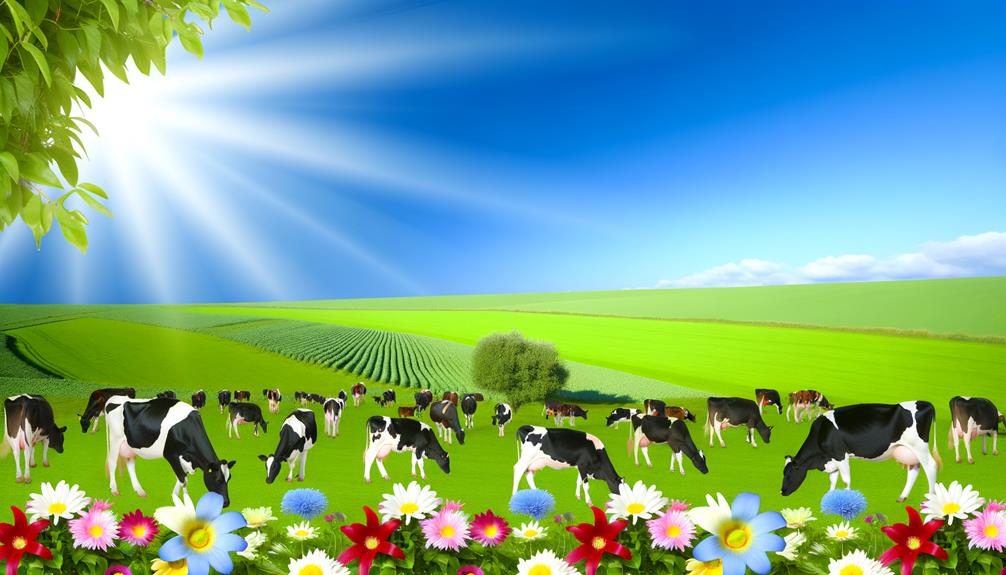
In biblical literature, the association of milch kine with fertility underscores the intrinsic link between divine provision and the perpetuation of life.
Milch kine, or milk-giving cows, symbolize not just physical sustenance but also the continuation of generations. The nurturing aspect of these animals is frequently illustrated within scriptural narratives, emphasizing their role in agrarian societies. Their presence signifies prosperity and the blessings of abundant life.
To evoke a deeper emotional connection, consider the following:
- Nourishment: Representing the essential sustenance for families and communities.
- Growth: Symbolizing the potential for expansion and flourishing of life.
- Prosperity: Reflecting divine favor and material well-being.
- Legacy: Highlighting the continuity of heritage and tradition through successive generations.
These elements collectively underscore the crucial role of milch kine in biblical contexts.
Divine Provision

Biblical narratives often depict milch kine as embodiments of divine provision, illustrating how these animals serve as tangible manifestations of God’s care and sustenance for His people. In the context of ancient Israel, where agrarian societies relied heavily on livestock, milch kine symbolized a direct link to divine benevolence.
For instance, in the story of Joseph in Egypt, the prosperity of Pharaoh’s kingdom is often represented through abundant cattle, including milch kine, underscoring God’s provision through times of famine and plenty.
Additionally, in the Levitical laws, the inclusion of milch kine within sacrificial systems highlights their role as divine gifts meant to guarantee community well-being. Consequently, milch kine in biblical texts embody a theologically rich symbol of God’s providence.
Agricultural Significance
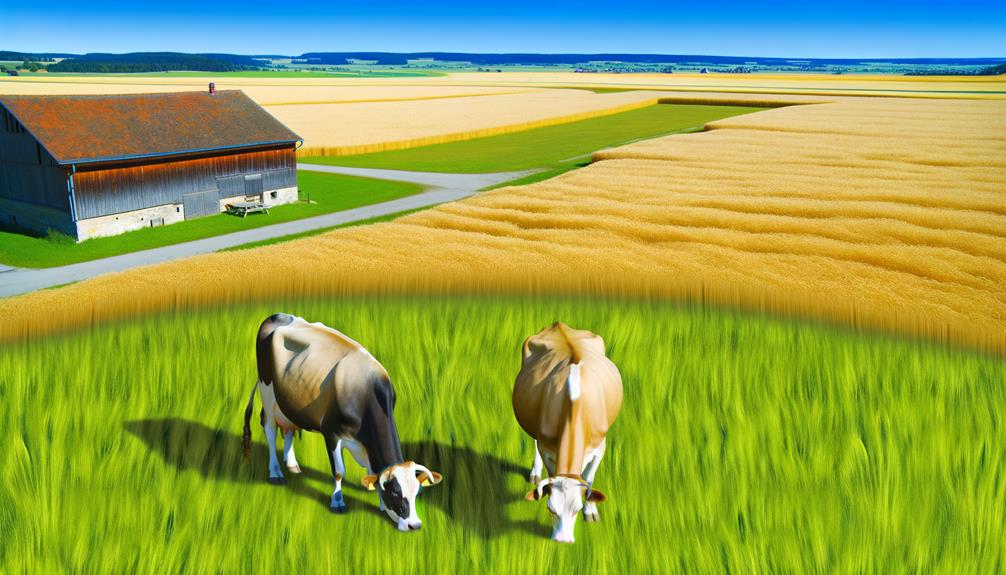
The term ‘milch kine‘ in biblical texts reflects the agricultural practices and priorities of ancient societies, particularly regarding sustenance and economic stability. Livestock, especially dairy cattle, are recurrently mentioned in scripture, symbolizing prosperity and divine blessing.
Examining the role of dairy production within these texts offers insight into the essential function of livestock in sustaining and enriching biblical communities.
Biblical Farming Practices
Among the various farming practices depicted in the Bible, the role of milch kine, or milk-producing cows, serves as a critical element in understanding the agricultural economy and sustenance of ancient Israelite society.
These cows were indispensable due to their contributions in several key areas:
- Nutritional Provision: Milch kine provided essential dairy products, such as milk and cheese, forming a staple in the diet.
- Economic Stability: The trade and sale of dairy products contributed to the economic resilience of households.
- Agricultural Support: Milch kine aided in plowing fields, enhancing crop production.
- Cultural Symbolism: They held symbolic significance, often representing prosperity and divine blessing.
Understanding these roles elucidates the multifaceted importance of milch kine in biblical agricultural practices.
Livestock in Scripture
Examining the agricultural significance of livestock in Scripture reveals their integral role in the sustenance, economy, and social structure of ancient Israelite communities. Livestock such as cattle, sheep, and goats were pivotal for their contributions to food supply, providing meat, milk, and other dairy products essential for nutrition.
Economically, the possession and management of livestock were indicators of wealth and stability, with livestock often serving as currency in trade and as offerings in religious practices.
Socially, livestock ownership fostered community relationships and hierarchical structures, reinforcing social bonds and obligations. Consequently, livestock were not merely agricultural assets but were woven into the very fabric of societal existence in biblical times, reflecting their profound significance.
Dairy Production Symbolism
Building on the foundational role of livestock in ancient Israelite society, dairy production emerges as a significant agricultural practice imbued with rich symbolic meaning in biblical texts.
Milk and dairy products often symbolize abundance, prosperity, and divine blessing. The imagery of ‘a land flowing with milk and honey’ epitomizes an idealized state of well-being and divine favor. Additionally, dairy production serves as an indicator of societal stability and sustenance.
Consider the following emotional evocations:
- Abundance: A symbol of God’s provision and ample resources.
- Prosperity: Reflects economic stability and flourishing communities.
- Divine Blessing: Represents the favor and grace bestowed by God.
- Sustenance: Highlights the essential, life-sustaining aspects of dairy in daily life.
These symbolic meanings underscore the profound agricultural and spiritual significance of dairy in biblical contexts.
Interpretations Over Time
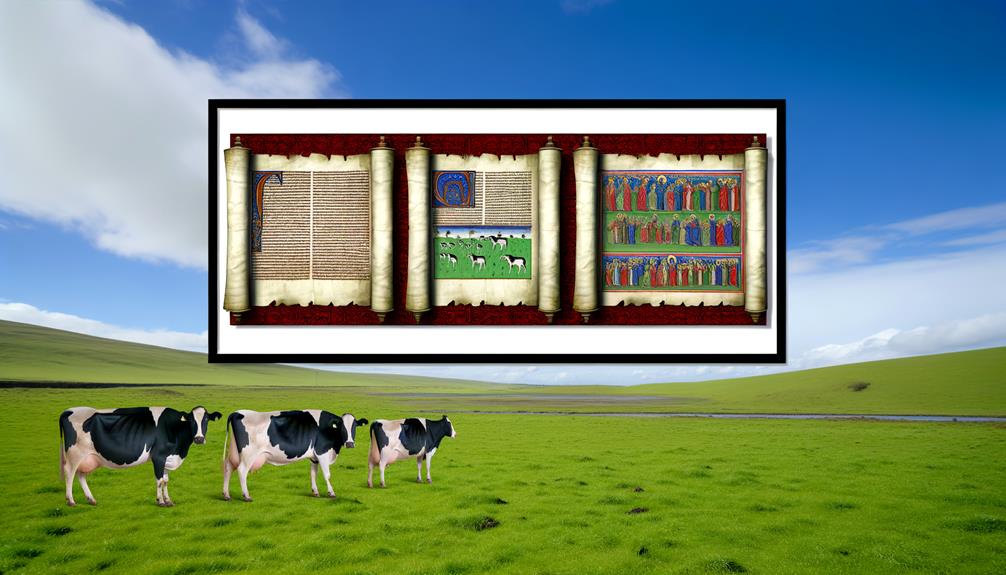
Tracing the evolution of the term ‘milch kine‘ in biblical translations reveals significant shifts in its interpretation and usage throughout history. Initially, ‘milch kine’ referred explicitly to cows that were actively producing milk, as seen in older translations such as the King James Version.
Over time, newer translations, including the New International Version, have opted for simpler terminology like ‘milk cows,’ aiming for greater accessibility and modern understanding. The term’s evolution reflects broader shifts in linguistic preferences and theological emphases, mirroring the dynamic nature of biblical exegesis.
Additionally, variations in interpretation may also be attributed to differing cultural contexts and advances in agricultural practices, underscoring the intricate interplay between scriptural text and its evolving audience.
Lessons for Today
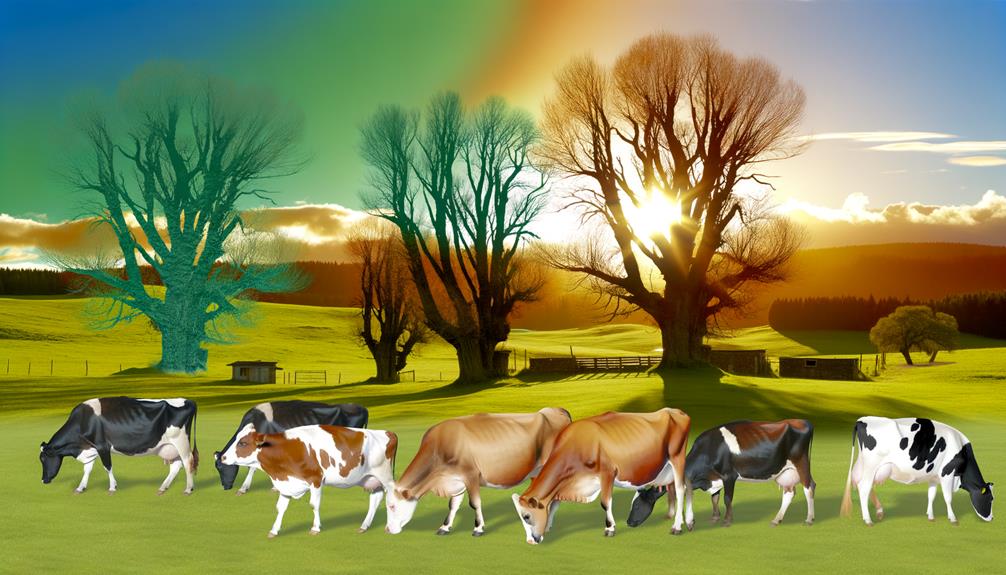
The evolving interpretation of ‘milch kine’ offers insights into how contemporary readers can engage with biblical texts in a manner that bridges ancient wisdom with modern relevance.
Analyzing ‘milch kine’ underscores the enduring values embedded in biblical narratives, emphasizing practical lessons for today.
- Sustenance and Provision: ‘Milch kine’ symbolize nourishment and care, reminding us of the importance of providing for our communities.
- Obedience and Faith: These cows, used in sacred rituals, reflect themes of obedience and faithfulness that transcend time.
- Simplicity and Humility: The humble nature of ‘milch kine’ encourages a return to simple, grounded living.
- Interconnectedness: The role of ‘milch kine’ in community settings highlights the interconnectedness of all life and the collective responsibility we share.
This analysis invites readers to find deeper, applicable meanings in biblical texts.
Conclusion
To summarize, the term ‘milch kine‘ within biblical texts not only denotes cows that produce milk but also embodies broader themes of fertility, divine provision, and agricultural significance.
Throughout history, interpretations have evolved, yet the core symbolism remains pertinent. The presence of milch kine in scripture underscores essential life-sustaining elements in ancient agrarian societies, akin to the role of modern-day industrial machinery in contemporary economies.
Such references continue to offer valuable insights into the cultural and spiritual fabric of biblical times.






